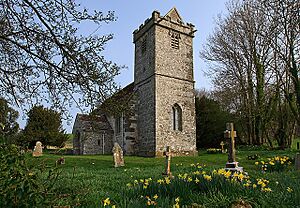St Mary the Virgin, Tarrant Crawford facts for kids
Quick facts for kids St Mary the Virgin |
|
|---|---|

The church in 2011
|
|
| Location | Tarrant Crawford, Dorset, England |
| Built | 12th century |
|
Listed Building – Grade I
|
|
| Official name: Church of St Mary | |
| Designated | 26 June 1953 |
| Reference no. | 1110840 |
| Lua error in Module:Location_map at line 420: attempt to index field 'wikibase' (a nil value). | |
The Church of St Mary the Virgin is a very old church located in Tarrant Crawford, a village in Dorset, England. It was built way back in the 12th century, which means it's over 800 years old! This church is considered a very important historical building. It's listed as a Grade I building, which is the highest level of protection for historic places in England. Today, it's looked after by the Churches Conservation Trust. This group helps to save old churches that are no longer used for regular services. The Trust took over care of the church on July 1, 1988.
This church is special because it's the only part left of a much larger place called Tarrant Abbey. The Abbey was started in the 13th century by a person named Ralph de Kahaines. It was a Cistercian nunnery, which means it was a home for a group of nuns.
Contents
The Church's History and Design
The oldest part of the church is the chancel, which is the area around the altar. It was built in the 12th century. The main part of the church, called the nave, along with its tower and porch, were added later in the 14th century.
Bells and Roof
The church's tower, built in the 15th century, holds three bells. Two of these bells are very old, from the medieval period. The third bell was made in the 17th century. The roof over the nave was put in place in the early 16th century. In 1911, the church had a big restoration project to fix and improve it.
Inside the Church
The inside of St Mary the Virgin Church is full of interesting historical items.
Ancient Coffin Lids
You can find several stone coffin lids from the 13th century inside. These lids were moved here from the old Abbey. They might belong to some famous people connected to the Abbey.
One important person was Queen Joan. She was the wife of Alexander II of Scotland and the daughter of King John of England. Queen Joan is believed to be buried in the churchyard, supposedly in a golden coffin!
Another famous person was Bishop Richard Poore. He was the person who oversaw the building of Salisbury Cathedral. Bishop Poore was baptised at Tarrant Abbey. Later, in 1237, he was buried there. He was an important church leader, serving as a bishop in different places like Chichester, Salisbury, and Durham.
Stained Glass and Furniture
The church also has beautiful stained glass windows from the 15th century. There's a font from the 16th century, which is used for baptisms. You can also see an octagonal pulpit and pews with carved wood panels from the 17th century.
Amazing Wall Paintings
One of the most amazing features is the wall paintings. These medieval paintings cover most of the walls in the nave and chancel. They were created in the 13th and 14th centuries.
One set of pictures shows stories about St Margaret of Antioch. Another painting from the 14th century shows the Annunciation. This is where the angel Gabriel, with wings, appears to the Virgin Mary.
On the south wall, there are two rows of paintings. The lower row shows three kings or princes and three skeletons. These pictures are thought to remind people that earthly power and wealth don't last forever.
Protecting the Church
After World War II, fewer people attended the church. Because of this, it was declared a redundant church and became the responsibility of the Churches Conservation Trust in 1988.
A lot of work has been done to keep the church safe and sound. About £100,000 was spent on fixing the stone walls and making sure the church was protected from the weather. Between 2003 and 2007, another £68,000 was spent. This money helped to improve the drainage around the church. It also helped to get rid of death watch beetle, which are insects that can damage wood. Finally, it helped to make the tower stable and put a new roof on it.
See also

